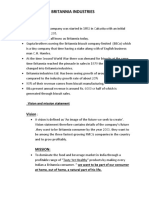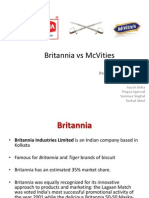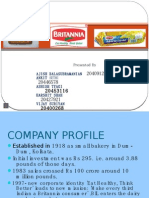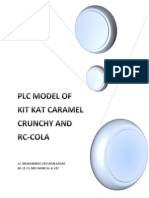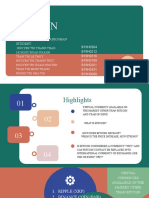Maggie N Yeepi Noodles Comprasion
Maggie N Yeepi Noodles Comprasion
Uploaded by
Shruti TrikhaCopyright:
Available Formats
Maggie N Yeepi Noodles Comprasion
Maggie N Yeepi Noodles Comprasion
Uploaded by
Shruti TrikhaOriginal Title
Copyright
Available Formats
Share this document
Did you find this document useful?
Is this content inappropriate?
Copyright:
Available Formats
Maggie N Yeepi Noodles Comprasion
Maggie N Yeepi Noodles Comprasion
Uploaded by
Shruti TrikhaCopyright:
Available Formats
Has Maggi finally got competition?
By Anushree Bhattacharyya, afaqs!, New Delhi, March 07, 2011 Section: News Category: Marketing
Share
2010 saw a sudden spurt in this instant noodles category with two major FMCG players, GSK and ITC venturing in. Besides, existing competitors are also trying for a rebound.
Circa 1982. All it took was two minutes to woo the hungry souls. The country had just been introduced to a revolutionary product, which took over hundreds of households by their hunger pangs, offering them an instant solution. Maggi Instant Noodles had entered the kitchens of India, the first one of its kind to do so. It was not only a new brand, but also a new food product for many Indians. It's been 28 years since then, and Indian consumers have continued to be loyal to the brand.
The reason is because Maggi has not had much competition. Even though it has been nearly three decades, the brand did not face any serious competition. Instead, in all these years, Maggi has grown exponentially to become a generic brand, and has single-handedly taken the instant noodles category from being almost non-existent, to a Rs 1,200 crore one, of which it currently has, as per industry estimates, a 70 per cent share, approximately. The only competition Maggi had until now was from the Japan-based Nissin Group's Top Ramen, and the Nepal based CG Foods' Wai-Wai Noodles. Wai-Wai, till recently, was restricted to the eastern market of West Bengal and Sikkim, where it controlled 70 per cent of the market. Its strategy was to first build-up the distribution network, which it successfully did the brand was available on the shelves of super stores, as much as in the local Kirana stores. It was then that they started building the brand.
Top Ramen, on the other hand, was aggressive in its marketing - it even roped in Shah Rukh Khan as the brand ambassador, but failed to get its distribution network in place. The brand had entered into a distribution tie-up with Marico, the owners of Saffola and Parachute. However, the year 2010 saw a sudden spurt in this category. Wai-Wai is now working towards a national presence. The company, which had manufacturing units in Assam and Sikkim, recently set up a new plant in Rudrapur, in Uttaranchal, and is also looking at acquiring a FMCG company in the South/ West. Top Ramen also has moved to set up its own distribution network, besides hiring a new agency Dentsu, to give it a fresh marketing push. The brand plans to launch itself with a new look and a new taste.
And... Two major FMCG players, GSK and ITC, decided to venture into the market, almost 20 years after Nissin Group's Top Ramen had decided to try its luck. GSK launched Foodles, while ITC launched Sunfeast Yippee. Unilever, too, tried to create some competition with Knorr Soupy Noodles. Instant Gains One reason why we see a spurt in this category is that it is still growing at the rate of 23 per cent. Prashant Pandey, general manager - marketing, GSK, says, "While it is true that consumers, both in the urban and semi-urban markets are aware of instant noodles, the markets in the hinterland and interiors are yet to be tapped. This provides a huge scope for growth. The category is yet to penetrate deeper into the deepest regions of this country," he says. The other reason that experts attribute to the growth is that the profit margins in the instant noodles category are very high. This was a lucrative proposition for companies such as GSK and ITC, which were looking to diversify into other categories. It is because of Maggi that instant noodles have become a part of the food habit of Indian homes. Maggi has moved from being a 7 pm-snack, to being a part of breakfast, lunch, and dinner, of the average Indian household. Says Sunil Alagh, chairman, SKA Advisors, "It is all thanks to Nestle, which has done the initial and crucial job of establishing the instant noodles category in the consumer's mindset." According to Alagh the market is ripe. "It's the perfect time for newer players to enter the category. They just need to launch a good tasty product, and work on its distribution," says Alagh. Tasting Times How well will the new brands be received? Brand consultant Ramanujam Sridhar, says, "The new entrants will perform well in areas where the brand equity of the parent company, or the brand itself is very high. For example, the Horlicks brand is very strong in the Tamil Nadu market, and there are chances that Foodles will do well in this market where it was first launched." Industry observers like independent consultant Cajetan Vaz and Prateek Srivastava, president, South, Ogilvy India (he was in-charge of Sunfeast Yippee campaign), feel that while there will be a place for many players in a growing category, the new entrants will have to find a differentiating factor, and build the concept through advertising and marketing. However, the new players still have a long way to go, especially when MAGGI continues to innovate itself with new product variations, be it Maggi Vegetable Atta Noodles, Maggi Vegetable Multigrainz Noodles, or several other variants.
Tags: Nestle, Maggi, ITC, Sunfeast Yippee, GlaxoSmithKline, Horlicks Foodles, Indo Nissin, Top Ramen, CG Foods, Wai-Wai, Sunil Alagh, SKA Advisors, Ramanujam Sridhar, Brand Comm, Cajetan Vaz, MNVV Prasad,Prashant Pandey, GSK, Prateek Srivastava, Ogilvy India, Dentsu Communications, Marico
Sunfeast Yippee Noodles: Targeting Maggie with Benefit Positioning
20DEC
Hello World Top Roman failed and so did Foodles. This time Maggi with 80% market share in India is again being targeted by ITCs sunfeast Yippie noodles with a slight different and a well thought out stratgey The below commercials of Sunfeast Yippee noodles are based on clear benefit positioning over Maggie. Lets have a look at them one by one 1. The above advert attacks the largest selling variant of Maggie, Maggie Masala, and gives consumers the choice of two masala Magic and Classic. The advert emphasizes that since we use choices in everything why should we settle with only one choice with maggie masala 2. The advert focuses on advantage of Yippee noodles on Maggie. Usually Maggie comes in rectangular shape and while cooking it is broken into two pieces (remember maggie adverts). It results into short pieces of noodles. On the contrary Yippee comes im round shape and can easily fits into round vessel with no breaking which results in long noodles 3. The biggest problem with cooked maggie is that it is to be eaten when freshly cooked. If you keep it for some time its noodle get sticky becomes inedible. This advert exposes the same disadvantage with Maggie and promises that Yipee noodles can be eaten even after some time. In the end Kudos to branding and research team of Yipee noodles for such a good positioning for its noodles brand. But still I feel lot to be done for Yipee. The biggest advantage for brands like Maggie is its taste and first mover advantage in the instant noodle market. The brand Maggie is now become generic for the category and mere advertising is not going to do any harm to Maggi. But the key to success for Yipee will be the taste (trials) and targeted promotional activities and good distribution (A key element since I believe some purchases for Maggie are not planned and Maggie acts as a substitute for meal)
Some where deep down also believe that most of the noodle brands target children only. Since the noodles in India is vastly consumed by Young population also, then why not target this group and segment the market. Divide and Conquer Any thoughts on this will be greatly appreciated See you soon Guys
Sunfeast Yippee Noodles: Targeting Maggie with Benefit Positioning
Hello World Top Roman failed and so did Foodles. This time Maggi with 80% market share in India is again being targeted by ITC's sunfeast Yippie noodles with a slight different and a well thought out stratgey The below commercials of Sunfeast Yippee noodles are based on clear benefit positioning over Maggie. Lets have a look at them one by one
http://www.youtube.com/watch?v=PU3WCgIDjb8&NR=1
1. The above advert attacks the largest selling variant of Maggie, Maggie Masala, and gives consumers the choice of two masala "Magic" and "Classic". The advert emphasizes that since we use choices in everything why should we settle with only one choice with maggie masala http://www.youtube.com/watch?v=7aIWsqb0jR0&feature=related 2. The advert focuses on advantage of Yippee noodles on Maggie. Usually Maggie comes in rectangular shape and while cooking it is broken into two pieces (remember maggie adverts). It results into short pieces of noodles. On the contrary Yippee comes im round shape and can easily fits into round vessel with no breaking which results in long noodles [http://www.youtube.com/watch?v=lIG5uUZQm9Q&feature=related] 3. The biggest problem with cooked maggie is that it is to be eaten when freshly cooked. If you keep it for some time its noodle get sticky becomes inedible. This advert exposes the same disadvantage with Maggie and promises that Yipee noodles can be eaten even after some time.
In the end Kudos to branding and research team of Yipee noodles for such a good positioning for its noodles brand. But still I feel lot to be done for Yipee. The biggest advantage for brands like Maggie is its taste and first mover advantage in the instant noodle market. The brand Maggie is now become generic for the category and mere advertising is not going to do any harm to Maggi. But the key to success for Yipee will be the taste (trials) and targeted promotional activities and good distribution (A key element since I believe some purchases for Maggie are not planned and Maggie acts as a substitute for meal) Some where deep down also believe that most of the noodle brands target children only. Since the noodles in India is vastly consumed by Young population also, then why not target this group and segment the market. "Divide and Conquer" Any thoughts on this will be greatly appreciated See you soon Guys
You might also like
- PLC Maggi Vs YippeeDocument14 pagesPLC Maggi Vs Yippeesorathia jigneshNo ratings yet
- Evolution of Rural MarketingDocument25 pagesEvolution of Rural MarketingttirvNo ratings yet
- Parle PPT (Final)Document28 pagesParle PPT (Final)Kopal Garg100% (1)
- Toaz - Info Nestle Final Report PRDocument45 pagesToaz - Info Nestle Final Report PRHarsh PradhanNo ratings yet
- Index: A Study On Marketing Promotion Strategies Adopted by Cadbury Dairy Milk With Reference To Gondia RegionsDocument42 pagesIndex: A Study On Marketing Promotion Strategies Adopted by Cadbury Dairy Milk With Reference To Gondia RegionsujwaljaiswalNo ratings yet
- EABD AnalysisDocument23 pagesEABD AnalysisNamit Baser100% (1)
- Product Life Cycle of MaggiDocument14 pagesProduct Life Cycle of MaggiSaloni Nanda100% (1)
- To Study Marketing Strategies of Britannia CompanyDocument19 pagesTo Study Marketing Strategies of Britannia CompanySANJOY KUMAR MITRANo ratings yet
- Future Goals of BATADocument12 pagesFuture Goals of BATAKausherNo ratings yet
- Soulflower - Aroma Industry - Final Report Ankit Kagra - Consumer BehaviorDocument35 pagesSoulflower - Aroma Industry - Final Report Ankit Kagra - Consumer BehaviorAnkit KagraNo ratings yet
- Role of Insurance Sector in The Economic Development of IndiaDocument24 pagesRole of Insurance Sector in The Economic Development of IndiaRajat SinghNo ratings yet
- Marketing BritanniaDocument6 pagesMarketing BritanniapriyaNo ratings yet
- Mission, Vision and Values of Marico LTD.: Link For ReferenceDocument9 pagesMission, Vision and Values of Marico LTD.: Link For ReferenceYash TiwariNo ratings yet
- Britannia Industries LimitedDocument3 pagesBritannia Industries Limiteddivyajeevan89No ratings yet
- Pitambri Products Pvt. Ltd.Document13 pagesPitambri Products Pvt. Ltd.Siddharth GautamNo ratings yet
- Synopsis - MARKETING AND DISTRIBUTION STRATEGIES OF BRITANNIADocument16 pagesSynopsis - MARKETING AND DISTRIBUTION STRATEGIES OF BRITANNIAChanpreet Singh GroverNo ratings yet
- Parle GDocument6 pagesParle GVikas BhadauriaNo ratings yet
- Interim Report - Aditi Agarwal PDFDocument23 pagesInterim Report - Aditi Agarwal PDFKritika Jalan100% (1)
- BRITANNIADocument3 pagesBRITANNIAsalmaNo ratings yet
- A Study On Sales Promotion: HKBK Degree Collegepage 1Document54 pagesA Study On Sales Promotion: HKBK Degree Collegepage 1B.NagamaddiletiNo ratings yet
- Nikhil Bhutada - Manyavar SIP Report - 2nd DraftDocument120 pagesNikhil Bhutada - Manyavar SIP Report - 2nd DraftKrishna kishor tiwariNo ratings yet
- A Comparative Study On Consumer Buying Behaviour Towards Maggi Noodles & Other Noodle With Reference To Gondia CityDocument5 pagesA Comparative Study On Consumer Buying Behaviour Towards Maggi Noodles & Other Noodle With Reference To Gondia CityujwaljaiswalNo ratings yet
- Competition To BritanniaDocument3 pagesCompetition To BritanniasurajNo ratings yet
- Internship Report FinalDocument54 pagesInternship Report FinalgeethaNo ratings yet
- Britannia Vs Mcvities: Presented by Group 4Document64 pagesBritannia Vs Mcvities: Presented by Group 4Pragya AgrawalNo ratings yet
- Research Project Report ON Marketing Strategy of Amul Submitted ToDocument80 pagesResearch Project Report ON Marketing Strategy of Amul Submitted Tokushagra JainNo ratings yet
- Britannia Industries LTDDocument18 pagesBritannia Industries LTDharry-bull00100% (2)
- MYSORE Sandal Soap FinalDocument13 pagesMYSORE Sandal Soap FinalNawaraj BasnetNo ratings yet
- Bajaj Auto: About The Bajaj GroupDocument16 pagesBajaj Auto: About The Bajaj GroupKiran JainNo ratings yet
- Advertising and Sales Promotion Techniques Used by Retail Businesses With Special Reference To Big BazaarDocument4 pagesAdvertising and Sales Promotion Techniques Used by Retail Businesses With Special Reference To Big BazaarDipanjan Das0% (2)
- PLC Model of Kit Kat Caramel CrunchyDocument6 pagesPLC Model of Kit Kat Caramel CrunchyJunaid YNo ratings yet
- ITC Limited Equity Research ReportDocument31 pagesITC Limited Equity Research ReportMithun SanjayNo ratings yet
- Maggi With OtherDocument55 pagesMaggi With OtherRavi JoshiNo ratings yet
- Saleas and Promotional Strategy of Amul Ice Cream NitilDocument93 pagesSaleas and Promotional Strategy of Amul Ice Cream NitilNitin R Gond50% (2)
- 4Ps of PantaloonsDocument15 pages4Ps of PantaloonsVibhav BhideNo ratings yet
- Research Methodology On MaggiDocument24 pagesResearch Methodology On MaggiSamar Iqbal100% (1)
- Analysis of Britannia Industry-Subham AgarwallaDocument57 pagesAnalysis of Britannia Industry-Subham AgarwallaSubham AgarwallaNo ratings yet
- Financial Statement Analysis - Group 3Document15 pagesFinancial Statement Analysis - Group 3Nayna MangliyaNo ratings yet
- AIMA QUIZ 2011 - Collected Questions From Diff SourcesDocument15 pagesAIMA QUIZ 2011 - Collected Questions From Diff SourcesnetygenNo ratings yet
- SIP Project WILDCRAFT (SANDEEP)Document50 pagesSIP Project WILDCRAFT (SANDEEP)nonamekoreanidNo ratings yet
- Sanket Dhariwal Final ProjectDocument71 pagesSanket Dhariwal Final ProjectSanjay Devkar0% (2)
- Parashuram Naik - Sunpure Oil - Ind - Presentation - Report - Ver1Document15 pagesParashuram Naik - Sunpure Oil - Ind - Presentation - Report - Ver1Shravan M B MBANo ratings yet
- S & D MahindraDocument14 pagesS & D MahindraPriyanshu SharmaNo ratings yet
- Parle G ProjectDocument22 pagesParle G ProjectMithlesh SinghNo ratings yet
- Maggi SBM FinalDocument37 pagesMaggi SBM FinalKhyati Dhabalia100% (1)
- Winter Internship Project Report (Nirmal)Document11 pagesWinter Internship Project Report (Nirmal)Annie Biju ThomasNo ratings yet
- Positioning in FMCG Sector: A Case Study of Parle-G Biscuit: Abhinav National Monthly Refereed Journal of Research inDocument6 pagesPositioning in FMCG Sector: A Case Study of Parle-G Biscuit: Abhinav National Monthly Refereed Journal of Research inAyush BishtNo ratings yet
- Aditya Awasthi (821025)Document54 pagesAditya Awasthi (821025)harshkeshwani07No ratings yet
- Parle G Marketing ProjectDocument8 pagesParle G Marketing ProjectSoumya TalwarNo ratings yet
- Final Imc Report - Group 5Document37 pagesFinal Imc Report - Group 5GeorgeNo ratings yet
- Presentation On ITC, Food DivisionDocument28 pagesPresentation On ITC, Food DivisionMD JAFAR SHARIFNo ratings yet
- SpykarDocument13 pagesSpykarRahul Raj50% (2)
- Jio (Marketing Strategy Analysis)Document28 pagesJio (Marketing Strategy Analysis)Anwar BNo ratings yet
- Vishal's ProjectDocument95 pagesVishal's Projectsanchittkool100% (1)
- ATOPDocument81 pagesATOPGosai JaydeepNo ratings yet
- Titan PPT For STMDocument14 pagesTitan PPT For STMJenifer Chrisla TNo ratings yet
- Big BazaarDocument26 pagesBig BazaaraKSHAT sHARMANo ratings yet
- Heli Flex Cables - SDM AssignmentDocument3 pagesHeli Flex Cables - SDM AssignmentKajol NigamNo ratings yet
- Green Products A Complete Guide - 2020 EditionFrom EverandGreen Products A Complete Guide - 2020 EditionRating: 5 out of 5 stars5/5 (1)
- Competitors of MaggiDocument5 pagesCompetitors of MaggiMridula DasNo ratings yet
- Final Sales and DistributionDocument18 pagesFinal Sales and DistributionShruti TrikhaNo ratings yet
- The Basic Objectives of The Board Were Identified AsDocument7 pagesThe Basic Objectives of The Board Were Identified AsShruti TrikhaNo ratings yet
- Human Resource PlanningDocument13 pagesHuman Resource PlanningShruti TrikhaNo ratings yet
- Human Resource ManagementDocument23 pagesHuman Resource ManagementShruti TrikhaNo ratings yet
- Big BasketDocument16 pagesBig Basketsunnykumar.m2325No ratings yet
- BUS 1101 Unit 3 - Learning JournalDocument3 pagesBUS 1101 Unit 3 - Learning Journaltalk2tomaNo ratings yet
- McDonald's Corporate Strategy Case Study (37506) PDFDocument49 pagesMcDonald's Corporate Strategy Case Study (37506) PDFRoy Stephan100% (1)
- VCL-9-A Universal Model of Leadership Lecture MaterialDocument6 pagesVCL-9-A Universal Model of Leadership Lecture MaterialS Varun SubramanyamNo ratings yet
- Test - Start Up India Scheme.Document2 pagesTest - Start Up India Scheme.sourabhsoni5890No ratings yet
- Fundamental IndexationDocument18 pagesFundamental IndexationRyadNo ratings yet
- SC GL TestDocument22 pagesSC GL TestlatifcomNo ratings yet
- Ana and Boy To Be PrintedDocument2 pagesAna and Boy To Be PrintedRegina Ranillo MabilinNo ratings yet
- Responsible Artificial Intelligence Principles at RELXDocument10 pagesResponsible Artificial Intelligence Principles at RELXcvpn55No ratings yet
- Slide 6Document31 pagesSlide 6KUDZANAI MUNDOGANo ratings yet
- Quantitative Techniques - Theories Part 2Document2 pagesQuantitative Techniques - Theories Part 2Ems TeopeNo ratings yet
- Bitcoin: Teacher: Do Thi Thanh Nhan StudentDocument23 pagesBitcoin: Teacher: Do Thi Thanh Nhan StudentMy Huyen TranNo ratings yet
- Ep16870-Cbp - Wap - Source Telecom - Fiber Optic Installation Inside 2quad Bldg. - 112822Document1 pageEp16870-Cbp - Wap - Source Telecom - Fiber Optic Installation Inside 2quad Bldg. - 112822Rhyan PantoNo ratings yet
- Free Elec 4 - Technopreneurship 2 Semester, SY 2020-2021 9 F'S Common Component of TechnopreneurshipDocument6 pagesFree Elec 4 - Technopreneurship 2 Semester, SY 2020-2021 9 F'S Common Component of TechnopreneurshipGerald LerioNo ratings yet
- LVMH Cover Letter SampleDocument2 pagesLVMH Cover Letter SamplezhaidanjieNo ratings yet
- Loan CapitalDocument30 pagesLoan CapitalniklynNo ratings yet
- Chapters 3 GBERMICDocument7 pagesChapters 3 GBERMICVillanueva, Jane G.No ratings yet
- Form O (Assam)Document2 pagesForm O (Assam)Shreya KumarNo ratings yet
- GE203 2020 OutlineDocument9 pagesGE203 2020 OutlineGisele MallamNo ratings yet
- CA New Project - PDF 1 AprilDocument55 pagesCA New Project - PDF 1 Aprilpratikshapatil0606No ratings yet
- PGP Practice Questions (Midterm)Document3 pagesPGP Practice Questions (Midterm)Aditya VidolkarNo ratings yet
- Group 5 Automated Smart Watering System Sensor and GSMDocument31 pagesGroup 5 Automated Smart Watering System Sensor and GSMjamesneil.basan.21No ratings yet
- Healthspan / Bon Secours Mercy Health Executive Summary - NHRMC RFPDocument7 pagesHealthspan / Bon Secours Mercy Health Executive Summary - NHRMC RFPBen SchachtmanNo ratings yet
- Operations Guide For RFM Solutions by Utopia For S/4HANA: Release 9.2Document8 pagesOperations Guide For RFM Solutions by Utopia For S/4HANA: Release 9.2Rahul GuptaNo ratings yet
- Book Chapter - Supply Chain Finance PerspectivesDocument26 pagesBook Chapter - Supply Chain Finance PerspectivesAli MkNo ratings yet
- Letters of Credit (Locs) Are Established On The Basis of Commercial Policy and EfficiencyDocument8 pagesLetters of Credit (Locs) Are Established On The Basis of Commercial Policy and EfficiencyTanya YadavNo ratings yet
- Iti CollegeDocument4 pagesIti Collegeronit.islwirelessNo ratings yet
- Deed of Transfer of Rights With Assumption of Obligation Pag Ibig BlankDocument4 pagesDeed of Transfer of Rights With Assumption of Obligation Pag Ibig BlankSherwin HermanoNo ratings yet
- Chapter 4: Main Factors Affecting Project Success: March 2017Document37 pagesChapter 4: Main Factors Affecting Project Success: March 2017Getasew AzezeNo ratings yet
- Pitching 1-2 SampleDocument17 pagesPitching 1-2 SampleLaíze LemosNo ratings yet


















